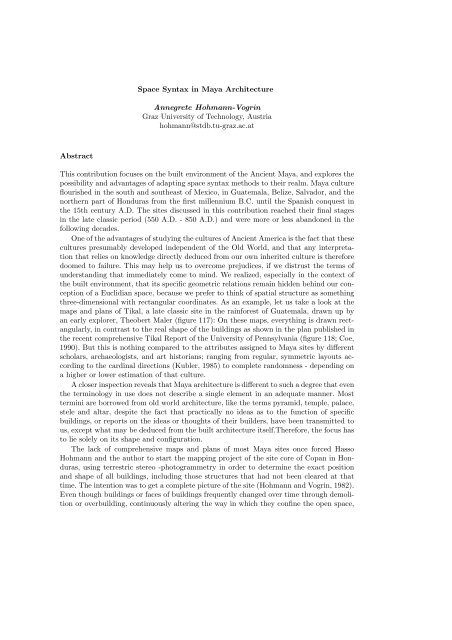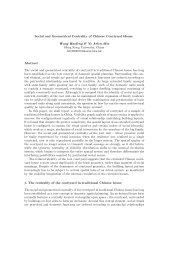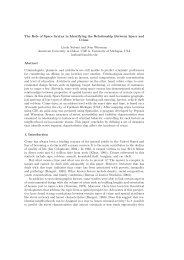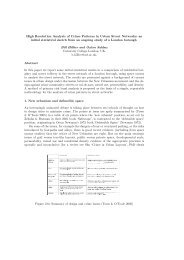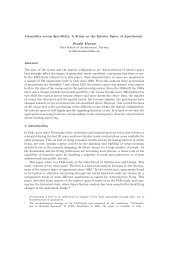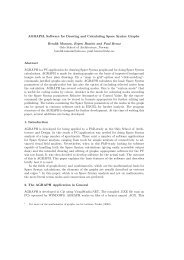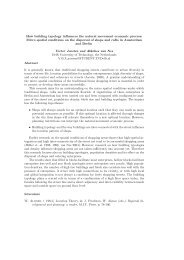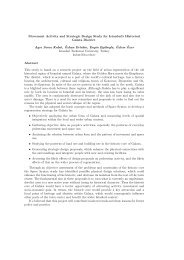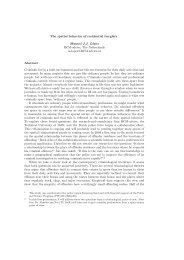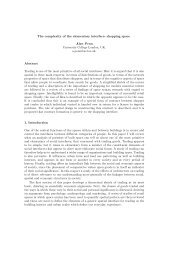Space Syntax in Maya Architecture Annegrete Hohmann-Vogrin ...
Space Syntax in Maya Architecture Annegrete Hohmann-Vogrin ...
Space Syntax in Maya Architecture Annegrete Hohmann-Vogrin ...
You also want an ePaper? Increase the reach of your titles
YUMPU automatically turns print PDFs into web optimized ePapers that Google loves.
<strong>Space</strong> <strong>Syntax</strong> <strong>in</strong> <strong>Maya</strong> <strong>Architecture</strong><br />
<strong>Annegrete</strong> <strong>Hohmann</strong>-Vogr<strong>in</strong><br />
Graz University of Technology, Austria<br />
hohmann@stdb.tu-graz.ac.at<br />
Abstract<br />
This contribution focuses on the built environment of the Ancient <strong>Maya</strong>, and explores the<br />
possibility and advantages of adapt<strong>in</strong>g space syntax methods to their realm. <strong>Maya</strong> culture<br />
flourished <strong>in</strong> the south and southeast of Mexico, <strong>in</strong> Guatemala, Belize, Salvador, and the<br />
northern part of Honduras from the first millennium B.C. until the Spanish conquest <strong>in</strong><br />
the 15th century A.D. The sites discussed <strong>in</strong> this contribution reached their f<strong>in</strong>al stages<br />
<strong>in</strong> the late classic period (550 A.D. - 850 A.D.) and were more or less abandoned <strong>in</strong> the<br />
follow<strong>in</strong>g decades.<br />
One of the advantages of study<strong>in</strong>g the cultures of Ancient America is the fact that these<br />
cultures presumably developed <strong>in</strong>dependent of the Old World, and that any <strong>in</strong>terpretation<br />
that relies on knowledge directly deduced from our own <strong>in</strong>herited culture is therefore<br />
doomed to failure. This may help us to overcome prejudices, if we distrust the terms of<br />
understand<strong>in</strong>g that immediately come to m<strong>in</strong>d. We realized, especially <strong>in</strong> the context of<br />
the built environment, that its specific geometric relations rema<strong>in</strong> hidden beh<strong>in</strong>d our conception<br />
of a Euclidian space, because we prefer to th<strong>in</strong>k of spatial structure as someth<strong>in</strong>g<br />
three-dimensional with rectangular coord<strong>in</strong>ates. As an example, let us take a look at the<br />
maps and plans of Tikal, a late classic site <strong>in</strong> the ra<strong>in</strong>forest of Guatemala, drawn up by<br />
an early explorer, Theobert Maler (figure 117): On these maps, everyth<strong>in</strong>g is drawn rectangularly,<br />
<strong>in</strong> contrast to the real shape of the build<strong>in</strong>gs as shown <strong>in</strong> the plan published <strong>in</strong><br />
the recent comprehensive Tikal Report of the University of Pennsylvania (figure 118; Coe,<br />
1990). But this is noth<strong>in</strong>g compared to the attributes assigned to <strong>Maya</strong> sites by different<br />
scholars, archaeologists, and art historians; rang<strong>in</strong>g from regular, symmetric layouts accord<strong>in</strong>g<br />
to the card<strong>in</strong>al directions (Kubler, 1985) to complete randomness - depend<strong>in</strong>g on<br />
a higher or lower estimation of that culture.<br />
A closer <strong>in</strong>spection reveals that <strong>Maya</strong> architecture is different to such a degree that even<br />
the term<strong>in</strong>ology <strong>in</strong> use does not describe a s<strong>in</strong>gle element <strong>in</strong> an adequate manner. Most<br />
term<strong>in</strong>i are borrowed from old world architecture, like the terms pyramid, temple, palace,<br />
stele and altar, despite the fact that practically no ideas as to the function of specific<br />
build<strong>in</strong>gs, or reports on the ideas or thoughts of their builders, have been transmitted to<br />
us, except what may be deduced from the built architecture itself.Therefore, the focus has<br />
to lie solely on its shape and configuration.<br />
The lack of comprehensive maps and plans of most <strong>Maya</strong> sites once forced Hasso<br />
<strong>Hohmann</strong> and the author to start the mapp<strong>in</strong>g project of the site core of Copan <strong>in</strong> Honduras,<br />
us<strong>in</strong>g terrestric stereo -photogrammetry <strong>in</strong> order to determ<strong>in</strong>e the exact position<br />
and shape of all build<strong>in</strong>gs, <strong>in</strong>clud<strong>in</strong>g those structures that had not been cleared at that<br />
time. The <strong>in</strong>tention was to get a complete picture of the site (<strong>Hohmann</strong> and Vogr<strong>in</strong>, 1982).<br />
Even though build<strong>in</strong>gs or faces of build<strong>in</strong>gs frequently changed over time through demolition<br />
or overbuild<strong>in</strong>g, cont<strong>in</strong>uously alter<strong>in</strong>g the way <strong>in</strong> which they conf<strong>in</strong>e the open space,
280 <strong>Annegrete</strong> <strong>Hohmann</strong>-Vogr<strong>in</strong><br />
Figure 117: Map of the central Part of Tikal, drawn by Teobert Maler between 1895 and<br />
1904
<strong>Space</strong> <strong>Syntax</strong> <strong>in</strong> <strong>Maya</strong> <strong>Architecture</strong> 281<br />
Figure 118: The same part of Tikal, the North Acropolis and the Great Plaza, mapped by<br />
the University of Pennsylvania (Coe, 1990)
282 <strong>Annegrete</strong> <strong>Hohmann</strong>-Vogr<strong>in</strong><br />
everyth<strong>in</strong>g that can be seen now was actually there at one po<strong>in</strong>t. This is the only stage<br />
we can reconstruct to represent the whole area (figure 119). The difficulties <strong>in</strong> describ<strong>in</strong>g<br />
the agglomerations of structures that are the results of frequent overbuild<strong>in</strong>g soon led to<br />
the realization that monumental build<strong>in</strong>g groups, which can be found <strong>in</strong> the core areas<br />
of ancient <strong>Maya</strong> cities, are among the best examples to demonstrate or understand the<br />
space-creat<strong>in</strong>g function of architecture, and that the description has to focus on the spatial<br />
configuration. Plazas, courtyards and causeways, platforms and terraces, were def<strong>in</strong>ed<br />
as the pr<strong>in</strong>cipal constituent elements (figure 120). Adequate documentation and analysis<br />
shall cover not only their specific spatial context, but also the structure of the cont<strong>in</strong>uous<br />
space thus created. On that basis, an <strong>in</strong>terpretation may focus on different aspects, for<br />
<strong>in</strong>stance on aspects concern<strong>in</strong>g physical control, or on aspects of cultural symbolization,<br />
as long as the analysis was not designed to answer only one question.<br />
Physical control addresses the reaction of the built environment to the specific environmental<br />
conditions: heat or cold, flora and fauna, heavy ra<strong>in</strong>s, water supply, transportation<br />
resistances, and availability of build<strong>in</strong>g materials. It has been shown that, to<br />
a certa<strong>in</strong> degree, the specific shape and layout of <strong>Maya</strong> settlements could be expla<strong>in</strong>ed<br />
only through these facts (<strong>Hohmann</strong>-Vogr<strong>in</strong>, 1998). In the same way, the built environment<br />
can also be an expression of cultural symbolization, represent<strong>in</strong>g the specific worldview<br />
of the <strong>Maya</strong> (<strong>Hohmann</strong>-Vogr<strong>in</strong>, 2000). Both approaches explore the <strong>in</strong>tentions beh<strong>in</strong>d the<br />
way the <strong>Maya</strong> built their world, and how they are reflected <strong>in</strong> the ultimate configuration<br />
of that world. In this field, my conclusions were drawn ma<strong>in</strong>ly on the basis of structural<br />
similarities supported by other archaeological, ethnographic, and epigraphic sources.<br />
The other - <strong>in</strong>timately related - questions address the effect of the built environment<br />
on human be<strong>in</strong>gs, i.e. how it could have been perceived at the time when it was <strong>in</strong> use,<br />
and whether this can tell us someth<strong>in</strong>g about the functional frame and the social milieu<br />
it generated.<br />
We may assume that it is aga<strong>in</strong> the overall configuration that determ<strong>in</strong>es: -functional<br />
possibilities of a specific area, as this def<strong>in</strong>itely depends on its position <strong>in</strong> the fabric as a<br />
whole, and - the social milieu, as this is constituted by the potential of space to generate<br />
mutual awareness and encounters.<br />
Most likely, the attempt to answer these questions still seems rather ambitious. I<br />
already tried to approach the first question <strong>in</strong> my dissertation, published later <strong>in</strong> “Die<br />
Architektur von Copan” (<strong>Hohmann</strong> and Vogr<strong>in</strong>, 1982). I sought to determ<strong>in</strong>e the centrality<br />
of the different areas <strong>in</strong> the Ma<strong>in</strong> Group <strong>in</strong> Copan, of plazas or courtyards, <strong>in</strong> comparison<br />
with their accessibility (<strong>Hohmann</strong> and Vogr<strong>in</strong>, 1982, p. 91), based on a method proposed<br />
by Norman Hammond <strong>in</strong> his work on Lubaantun (Hammond, 1975, p. 78-83). This was a<br />
rather simple and rough approach.<br />
S<strong>in</strong>ce the publication of “The social Logic of space” (Hillier and Hanson, 1984), my plan<br />
had been to apply space syntax concepts to <strong>Maya</strong> urbanism. At first sight, especially the<br />
concept and def<strong>in</strong>ition of “convex space” was appeal<strong>in</strong>g and suitable <strong>in</strong> the context of <strong>Maya</strong><br />
towns, but differences turned out to prevail. Hillier and his colleagues have <strong>in</strong>vestigated<br />
ma<strong>in</strong>ly the old European cities, or what he and we would designate as “normal cities”,<br />
def<strong>in</strong>ed as variations of the follow<strong>in</strong>g:<br />
“Build<strong>in</strong>gs are arranged <strong>in</strong> outward-fac<strong>in</strong>g blocks so that build<strong>in</strong>g entrances cont<strong>in</strong>uously<br />
open to the space of public access. The space of public access is arranged <strong>in</strong> a series<br />
of <strong>in</strong>tersect<strong>in</strong>g r<strong>in</strong>gs that are regularized by a greater or lesser degree of l<strong>in</strong>earization of<br />
space to form the - more or less deformed - grid of the town. Through this l<strong>in</strong>earization<br />
the larger-scale structure of the town is made <strong>in</strong>telligible both to the peripatetic <strong>in</strong>dividual
<strong>Space</strong> <strong>Syntax</strong> <strong>in</strong> <strong>Maya</strong> <strong>Architecture</strong> 283<br />
Figure 119: Map of the central Part of Tikal, drawn by Teobert Maler between 1895 and<br />
1904
284 <strong>Annegrete</strong> <strong>Hohmann</strong>-Vogr<strong>in</strong><br />
Figure 120: Perspective draw<strong>in</strong>g of the Ma<strong>in</strong>group of Copan by H. <strong>Hohmann</strong> (<strong>Hohmann</strong><br />
and Vogr<strong>in</strong>, 1982)<br />
mov<strong>in</strong>g about with<strong>in</strong> the town and to the stranger arriv<strong>in</strong>g at its edges. The l<strong>in</strong>ear structure<br />
l<strong>in</strong>ks the build<strong>in</strong>g entrances directly to a pattern of space, which also l<strong>in</strong>ks closely<br />
to the edges of the town. The effect of this control of the l<strong>in</strong>ear organization of space is<br />
to create a structure <strong>in</strong> the ‘axial map’ of the town, that is a distribution of local and<br />
global ‘<strong>in</strong>tegration’, which becomes the most powerful functional mechanism driv<strong>in</strong>g first<br />
the pattern of movement and, through this, the distribution of land uses, build<strong>in</strong>g densities<br />
and larger-scale spatial and physical elements such as open spaces and landmarks.”<br />
(Hillier, 1996, p. 215).<br />
I presume that there is no need to expla<strong>in</strong> space syntax theory <strong>in</strong> detail here, but to<br />
recollect the def<strong>in</strong>ition of “normal cities” it is essential to expla<strong>in</strong> the differences. He then<br />
concludes: “The essence of urban form is that it is spatially structured and functionally<br />
driven. Between structure and function is the notion of <strong>in</strong>telligibility, def<strong>in</strong>ed as the degree<br />
to which what can be seen and experienced locally <strong>in</strong> the system allows the large-scale<br />
system to be learnt without conscious effort. Structure, <strong>in</strong>telligibility and function permit<br />
us to see the town as social process, and the fundamental element <strong>in</strong> all three is the l<strong>in</strong>ear<br />
spatial element, or axis.” (Hillier, 1996, p. 215)<br />
Hillier then compares these cities or towns with others that he designates as “strange<br />
towns” - cities or towns which do not conform to the rules def<strong>in</strong>ed for “normal towns”<br />
- <strong>in</strong>clud<strong>in</strong>g amongst them the cities of the Ancient <strong>Maya</strong>. He arrives at the conclusion,<br />
that <strong>in</strong> “strange towns”, axes are not <strong>in</strong>struments but symbols, the spatial configuration<br />
therefore be<strong>in</strong>g rather more symbolic than functional (Hillier, 1996, p. 222). He refers<br />
<strong>in</strong>ter alia to Teotihuacan with its s<strong>in</strong>gle axes l<strong>in</strong>ed by monumental build<strong>in</strong>g complexes<br />
<strong>in</strong>clud<strong>in</strong>g the Pyramid of the Sun and end<strong>in</strong>g at the Pyramid of the Moon. The isolated<br />
axes can only be seen as symbols express<strong>in</strong>g social power through dom<strong>in</strong>ation, and not<br />
as <strong>in</strong>struments <strong>in</strong>tended to guide movement <strong>in</strong>to the adjacent, more profane parts of the<br />
city. He l<strong>in</strong>ks the occurrence of this type of axis to societies. “where the needs of social
<strong>Space</strong> <strong>Syntax</strong> <strong>in</strong> <strong>Maya</strong> <strong>Architecture</strong> 285<br />
Figure 121: Central part of Teotihuacan drawn by A. <strong>Hohmann</strong>-Vogr<strong>in</strong> after Millon (Millon,<br />
1973)<br />
reproduction are dom<strong>in</strong>ant over the needs of social production” (Hillier 1996, p. 232).<br />
He also addresses the <strong>Maya</strong> towns or “proto-towns” - follow<strong>in</strong>g earlier scientific concepts.<br />
Here, th<strong>in</strong>gs are even more confus<strong>in</strong>g from his po<strong>in</strong>t of view. No global spatial<br />
organization seems to be present at all. He refers to the map of Tikal (figure 122) by<br />
Robert F. Carr and James Hazard (Carr and Hazard, 1961), which <strong>in</strong>dicates only the<br />
rema<strong>in</strong>s of stone build<strong>in</strong>gs float<strong>in</strong>g on the undulat<strong>in</strong>g terra<strong>in</strong>, shown by means of contour<br />
l<strong>in</strong>es - a rough ground plan. For “normal towns”, a ground plan might be enough to analyze<br />
the spatial structure, as people usually move at street level, as <strong>in</strong> a system of channels<br />
conf<strong>in</strong>ed by vertical elements. For <strong>Maya</strong> towns, the use of a ground plan alone is far too<br />
superficial, as will be shown later. <strong>Maya</strong> sites are like landscapes, resembl<strong>in</strong>g mounta<strong>in</strong>s,<br />
hills, valleys and pla<strong>in</strong>s. Open spaces are constituted by plazas, courtyards, terraces and<br />
platforms on different levels, while <strong>in</strong>terior space is relatively limited. In some cases, access<br />
to higher levels was obviously restricted. The stairways become narrower nearer to the<br />
top, sometimes they were even blocked off by overbuild<strong>in</strong>g. Step by step, terraces and<br />
platforms become smaller. Sights and views are determ<strong>in</strong>ed by the altitude of the respective<br />
terrace or platform. On the lowest level, the view is limited by walls and platforms<br />
taller than the viewer, at least <strong>in</strong> the smaller courtyards. The field of vision is widened by<br />
access to higher levels. On the highest level - presumably never reached by the average<br />
person - the view becomes unlimited, so to speak. Here, social hierarchy is demonstrated<br />
literally. This is both functional and symbolic (figure 119, figure 120).<br />
As stated above, there are wide causeways <strong>in</strong> many places that mutually connect groups<br />
of monumental architecture - as is shown <strong>in</strong> the central part of the map of Tikal (figure<br />
123). These causeways never form a ma<strong>in</strong> axis, as is the case <strong>in</strong> Teotihuacan, though they<br />
connect groups of monumental structures, the more everyday build<strong>in</strong>gs adjacent to, but<br />
not directly l<strong>in</strong>ked with the causeways. They are mostly not conf<strong>in</strong>ed by walls or build<strong>in</strong>gs<br />
that might close off the view, def<strong>in</strong><strong>in</strong>g l<strong>in</strong>es of visibility. Therefore, they do not necessarily<br />
guide movement visually. In effect, <strong>in</strong> <strong>Maya</strong> towns or cities, there are no l<strong>in</strong>ear spatial<br />
elements to be represented through axes, the ma<strong>in</strong> constituents of “normal towns”, so
286 <strong>Annegrete</strong> <strong>Hohmann</strong>-Vogr<strong>in</strong><br />
Figure 122: General map of Tikal by Carr and Hazard (Carr and Hazard 1961).
<strong>Space</strong> <strong>Syntax</strong> <strong>in</strong> <strong>Maya</strong> <strong>Architecture</strong> 287<br />
important for Hillier’s analysis.<br />
Can the concept of “space syntax” then be productive at all How can we start an analysis<br />
of these towns that aims at detect<strong>in</strong>g the constituents of spatial order, and at draw<strong>in</strong>g<br />
further conclusions regard<strong>in</strong>g functional possibilities or aspects of the social milieu<br />
Address<strong>in</strong>g the question of functional possibilities, we may simply ask for the <strong>in</strong>tegration<br />
values of the different areas def<strong>in</strong><strong>in</strong>g convex maps with an appropriate tessellation to<br />
take <strong>in</strong>to account the vary<strong>in</strong>g dimensions of the spatial elements (Hillier, 1996, p. 96). It<br />
would also be necessary to consider their different levels. In order to do this, the procedure<br />
would need to be extended by add<strong>in</strong>g a value for gett<strong>in</strong>g from one level to the next. As<br />
stated above, <strong>in</strong> analyz<strong>in</strong>g the spatial structure of Copan, the author has already made<br />
an attempt to def<strong>in</strong>e accessibility and centrality of the different areas <strong>in</strong> the Ma<strong>in</strong> Group<br />
<strong>in</strong> Copan <strong>in</strong> a much simpler way (<strong>Hohmann</strong> and Vogr<strong>in</strong> 1982, p. 91). A more detailed<br />
and reliable distribution of <strong>in</strong>tegration values for the different areas could give us better<br />
<strong>in</strong>dications for the more public or more private character of specific areas, and whether<br />
they were designed to be accessible to everybody or to a m<strong>in</strong>ority. These are the ma<strong>in</strong><br />
constituents for determ<strong>in</strong><strong>in</strong>g function <strong>in</strong> general.<br />
As expla<strong>in</strong>ed above, <strong>Maya</strong> towns do not show l<strong>in</strong>ear spatial elements, so important<br />
for the orientation <strong>in</strong> “normal towns”. The horizontal axis guid<strong>in</strong>g the flow of people <strong>in</strong><br />
“normal towns” was not relevant at all <strong>in</strong> this context It can be recognized without any<br />
detailed analysis that orientation and result<strong>in</strong>g physical movement <strong>in</strong> <strong>Maya</strong> towns are<br />
obviously guided by the altitude of monumental structures that could be seen from afar.<br />
Intelligibility of the overall pattern was also easy to assume, as these structures or groups<br />
of monumental structures usually showed different faces on each side and, <strong>in</strong>terest<strong>in</strong>gly<br />
enough, despite the absence of symmetry <strong>in</strong> spatial arrangements, these faces or facades<br />
are often symmetrical, emphasiz<strong>in</strong>g verticality. In most cases, the height of the ma<strong>in</strong><br />
groups is the result of frequent overbuild<strong>in</strong>g. Overbuild<strong>in</strong>g also needs more space at the<br />
base of the structures and may have required the extension of the plazas at the front<br />
to reta<strong>in</strong> an adequate field of vision. The causeways may have had a similar function.<br />
The growth of a site may therefore have started out as a random process, or from the<br />
topological configuration of small housemound groups, but then had to follow regularities<br />
lead<strong>in</strong>g to a more geometric order. These observations are quite general, made without<br />
a comprehensive analysis or further proof. But they already allow us to state that the<br />
obvious randomness of structures as shown here <strong>in</strong> the ground plan of Tikal (figure 122)<br />
and Copan (figure 124) will be relativized, add<strong>in</strong>g the 3rd dimension. Even the “paradox<br />
of centrality” (“maximiz<strong>in</strong>g <strong>in</strong>ternal <strong>in</strong>tegration also maximises external segregation”),<br />
and consequently the “paradox of visibility” (“arrang<strong>in</strong>g a series of urban areas <strong>in</strong> a l<strong>in</strong>e<br />
maximises the mean trip length and maximises also visibility”) are presumably not valid<br />
<strong>in</strong> configurations where different heights are the ma<strong>in</strong> constituents.<br />
Integrat<strong>in</strong>g the 3rd dimension will therefore be essential <strong>in</strong> the analysis <strong>in</strong> order to get<br />
relevant results <strong>in</strong> this context. A spatial model of visibility will be necessary for expand<strong>in</strong>g<br />
space syntax to <strong>in</strong>clude these spatial cultures.<br />
Start<strong>in</strong>g from the model of “all l<strong>in</strong>e visibility” (Hillier, 1996, p. 345), we must state<br />
that the l<strong>in</strong>es are not l<strong>in</strong>es <strong>in</strong> reality. A l<strong>in</strong>e shown <strong>in</strong> the plan is the <strong>in</strong>tersection of a<br />
vertical plane with the horizontal plane of representation, <strong>in</strong> most cases the ground plan,<br />
the vertical plane conta<strong>in</strong><strong>in</strong>g all possible l<strong>in</strong>es of sight there<strong>in</strong>. In the 3-dimensional model,<br />
that vertical plane <strong>in</strong>tersects the elevation of structures, and as these structures <strong>in</strong> “normal<br />
cities” are mostly vertical, the <strong>in</strong>tersection l<strong>in</strong>e of the two planes is vertical, shown as a<br />
po<strong>in</strong>t <strong>in</strong> the ground plan. This is not the case <strong>in</strong> the context of <strong>Maya</strong> architecture. The
288 <strong>Annegrete</strong> <strong>Hohmann</strong>-Vogr<strong>in</strong><br />
Figure 123: Part of the general map of Tikal by Carr and Hazard (Carr and Hazard, 1961)
<strong>Space</strong> <strong>Syntax</strong> <strong>in</strong> <strong>Maya</strong> <strong>Architecture</strong> 289<br />
vertical planes are <strong>in</strong>tersect<strong>in</strong>g low structures <strong>in</strong> the foreground, with higher structures<br />
beh<strong>in</strong>d them, and all of them have stepped-back facades. It will not be easy to reduce these<br />
<strong>in</strong>tricate limits of visibility to get at a practicable model.Furthermore, a comprehensive<br />
mapp<strong>in</strong>g of the sites to be studied would be necessary, at least equal to our maps of Copan,<br />
as spatial analysis requires the complete coverage of the built-up area <strong>in</strong> question.<br />
As our work on Copan has shown, there are strong <strong>in</strong>dications that this could be<br />
reward<strong>in</strong>g. A careful analysis of the site map (figure 124) has shown that there are <strong>in</strong>terest<strong>in</strong>g<br />
spatial relations to be found, based mostly on visual alignments, which means that<br />
facades, vertices or centrel<strong>in</strong>es of structures or monuments are coord<strong>in</strong>ated by the same<br />
vertical plane. In the ground plan, this plane is shown as one l<strong>in</strong>e, the <strong>in</strong>tersection l<strong>in</strong>e.<br />
Centre l<strong>in</strong>es or symmetry axes order<strong>in</strong>g the monumental facades or faces of structures are<br />
often emphasized through alignments with the edges of massive build<strong>in</strong>gs <strong>in</strong> front of them.<br />
As an example, I would like to po<strong>in</strong>t out some of these relations <strong>in</strong> Copan: - the edge of the<br />
western ball court build<strong>in</strong>g, Structure 9, is aligned with the symmetry axis of the facade<br />
of Structure 11; - the edge of Structure 7 with the symmetry axis of the Hieroglyphic<br />
Stairway, Structure 26; - the southern edge of Platform 3 with the centre l<strong>in</strong>e of Structure<br />
4; - the west court also shows <strong>in</strong>terest<strong>in</strong>g alignments between Structure14 and Structure<br />
12, rather a stage but called the “Review<strong>in</strong>g Stand”, and - the front wall of Structure<br />
11 is <strong>in</strong> l<strong>in</strong>e with the centre l<strong>in</strong>e of Structure 8 and that of the small build<strong>in</strong>g adjacent<br />
to Structure 21. L<strong>in</strong>es of sight are often established by significant edges of structures or<br />
elements of structures, but also by symmetry axes or centre l<strong>in</strong>es.<br />
Alignments were recognized <strong>in</strong> Copan at different levels and are obviously present <strong>in</strong><br />
many other <strong>Maya</strong> sites. In the Ma<strong>in</strong> Group of Copan, they occur <strong>in</strong> the layout of the courts<br />
and the position<strong>in</strong>g of the elements form<strong>in</strong>g the respective space boundary, and they occur<br />
<strong>in</strong> the position<strong>in</strong>g of stone monuments <strong>in</strong> the ma<strong>in</strong> plaza, where the monuments of the<br />
13th ruler of Copan seem to be set <strong>in</strong> l<strong>in</strong>e with monuments of some of his predecessors<br />
(<strong>Hohmann</strong>-Vogr<strong>in</strong>, 1989)<br />
Alignments are also suitable to anchor build<strong>in</strong>gs <strong>in</strong> the cosmic realm: Align<strong>in</strong>g build<strong>in</strong>gs<br />
to the ris<strong>in</strong>g or sett<strong>in</strong>g po<strong>in</strong>ts of the sun or other celestial bodies also means that the<br />
build<strong>in</strong>g is related to a special day <strong>in</strong> the respective cycle. There is some evidence for this<br />
practice <strong>in</strong> Copan and at other <strong>Maya</strong> sites.<br />
It is also <strong>in</strong>terest<strong>in</strong>g to po<strong>in</strong>t out that order<strong>in</strong>g along straight l<strong>in</strong>es or align<strong>in</strong>g is a<br />
very basic operation that does not require knowledge of abstract concepts of space. It is<br />
therefore a very flexible way of establish<strong>in</strong>g mean<strong>in</strong>gful relations <strong>in</strong> the built environment.<br />
In addition, the alignment of elements is a suitable method for govern<strong>in</strong>g the order<strong>in</strong>g<br />
of successive build<strong>in</strong>g phases that produced the aggregations of <strong>Maya</strong> centres. With the<br />
help of alignments, a new build<strong>in</strong>g or the new face of a build<strong>in</strong>g can be put <strong>in</strong> relation to<br />
exist<strong>in</strong>g architecture, the landscape, and even to the cosmic realm - and thus communicate<br />
<strong>in</strong>tention and mean<strong>in</strong>g (<strong>Hohmann</strong>-Vogr<strong>in</strong>, 2000). This also belongs to the realm of symbolic<br />
representation. But the obvious <strong>in</strong>tentionality of these relations is a strong <strong>in</strong>dication that<br />
visibility was a ma<strong>in</strong> concern <strong>in</strong> the creation of <strong>Maya</strong> architecture and urbanism, and that<br />
therefore a spatial model of visibility would be most reward<strong>in</strong>g. It would <strong>in</strong>ter alia reveal<br />
more about the <strong>in</strong>teraction of different strata of <strong>Maya</strong> society.<br />
Go<strong>in</strong>g back to the example of Teotihuacan and the notion of the merely symbolic<br />
function of its long s<strong>in</strong>gle axis <strong>in</strong>dicat<strong>in</strong>g a society governed by cultural reproduction, I<br />
would like to po<strong>in</strong>t out that I prefer to see Teotihuacan as a special case of Mesoamerican<br />
urbanism, with a s<strong>in</strong>gle, extremely elongated plaza def<strong>in</strong>ed by monumental structures<br />
and surrounded by a densely built-up area conta<strong>in</strong><strong>in</strong>g a great variety of compounds with
290 <strong>Annegrete</strong> <strong>Hohmann</strong>-Vogr<strong>in</strong><br />
Figure 124: Significant alignments <strong>in</strong> the Ma<strong>in</strong> Group of Copán (<strong>Hohmann</strong>-Vogr<strong>in</strong>)
<strong>Space</strong> <strong>Syntax</strong> <strong>in</strong> <strong>Maya</strong> <strong>Architecture</strong> 291<br />
very different properties (Millon, 1992; Pastory, 1997). This would <strong>in</strong>dicate that cultural<br />
production as well as cultural reproduction was present here.<br />
Conclud<strong>in</strong>g, I may state that a configurational analysis follow<strong>in</strong>g the ideas of Hillier’s<br />
space syntax seems very promis<strong>in</strong>g <strong>in</strong> the field of <strong>Maya</strong> urbanism. Determ<strong>in</strong><strong>in</strong>g spatial<br />
laws for that particular culture would be a big step towards a general theory of built<br />
space. But the procedure of the analysis must be extended significantly; for their “spatial<br />
culture” is, as can now be seen, truly different, <strong>in</strong> every respect.<br />
Literature<br />
Carr, R. F., and Hazzard, J. (1961) Map of the Ru<strong>in</strong>s of Tikal, El Peten,<br />
Guatemala, Tikal Report, No. 11, Philadelphia, University Museum, University of<br />
Pennsylvania.<br />
Coe, M. D. (1998) The <strong>Maya</strong>, 5th edition, London, Thames and Hudson.<br />
Coe, W. R. (1990) Excavations <strong>in</strong> the Great Plaza, North Terrace and North Acropolis<br />
of Tikal, Tikal Report No. 14., Philadelphia, The University Museum, University of<br />
Pennsylvania.<br />
Fash, W. L., (1998) Dynastic Architectural Programs: Intention and Design <strong>in</strong> Classic<br />
<strong>Maya</strong> Build<strong>in</strong>gs at Copan and Other Sites <strong>in</strong>: Housten, S. (ed.) Function and Mean<strong>in</strong>g<br />
<strong>in</strong> Classic <strong>Maya</strong> <strong>Architecture</strong>, <strong>in</strong>: A Symposium at Dumbarten Oaks, 7th and<br />
8th October 1994, Wash<strong>in</strong>gton, D.C..<br />
Hammond, N.,(1975) Lubaantun, A Classic <strong>Maya</strong> Realm. Peabody Museum Monographs<br />
No. 2, Cambridge, Mass, Cambridge University Press.<br />
Harrison, P. D. (1999) The Lords of Tikal, Rulers of an Ancient <strong>Maya</strong> City, London,<br />
Thames and Hudson, p. 180-191.<br />
Hillier, B.,(1996) <strong>Space</strong> is the Mach<strong>in</strong>e, A Configurational Theory of <strong>Architecture</strong>,<br />
Cambridge, Cambridge University Press.<br />
Hillier, B. and J. Hanson (1984) The Social Logic of <strong>Space</strong>, Cambridge, Cambridge<br />
University Press.<br />
<strong>Hohmann</strong>-Vogr<strong>in</strong>, A.M. (1989) The spatial relationships of monuments at Copán and<br />
Quiriguá, <strong>in</strong>: In de la Garca, M. (ed.) Memorias del Segundo Coloquio Internacional<br />
de Mayistas, Vol. I, México D.F., Universidad Nacional Autónoma de México.<br />
<strong>Hohmann</strong>-Vogr<strong>in</strong>, A.M. (1998) Siedlungsform und Klima <strong>in</strong> den frühen Kulturen<br />
Mesoamerikas Nachrichtenblatt der Archäologischen Gesellschaft Steiermark<br />
(AGST), 1998(1), p. 49-58.<br />
<strong>Hohmann</strong>-Vogr<strong>in</strong>, A.M.(2000) Lubaantun, El espacio estructurado y la visión del<br />
mundo, <strong>in</strong>: Arquitectura e ideología de los antiguos <strong>Maya</strong>s: Memoria de la Segunda<br />
Mesa Redonda de Palenque México D.F., Conaculta INAH, México.<br />
<strong>Hohmann</strong>-Vogr<strong>in</strong>, A.M. (2001) Unity <strong>in</strong> <strong>Space</strong> and Time, the <strong>Maya</strong> <strong>Architecture</strong>, <strong>in</strong>:<br />
Grube, N. (ed.), <strong>Maya</strong> Div<strong>in</strong>e K<strong>in</strong>gs of the Ra<strong>in</strong>forest, Köln, Koenemann.<br />
<strong>Hohmann</strong>, H. and Vogr<strong>in</strong>, A.M. (1996) Die Architektur von Copán (Honduras),<br />
Vermessung, Plandarstellung, Untersuchung der baulichen Elemente und des räumlichen<br />
Konzepts, A Configurational Theory of <strong>Architecture</strong>, Graz, Akademische<br />
Druck und Verlagsanstalt.<br />
Kubler, G. (1985) The Design of <strong>Space</strong> <strong>in</strong> <strong>Maya</strong> <strong>Architecture</strong>, <strong>in</strong>: Reese, T. (ed.), Studies<br />
<strong>in</strong> Ancient American and European Art, The Collected Essays of George Kubler,<br />
New Haven and London, Yale University Press.
292 <strong>Annegrete</strong> <strong>Hohmann</strong>-Vogr<strong>in</strong><br />
Millon, R. (ed.),(1973) The Teotihuacan Map, <strong>in</strong>: Urbanization at Teotihuacan, Mexico<br />
(ed.), Urbanization at Teotihuacan, Mexico, Vol. 1, Aust<strong>in</strong>, University of Texas<br />
Press.<br />
Millon, R. (1992) Teotihuacan Studies: From 1950 to 1990 and Beyond Dumbarton<br />
Oaks, Wash<strong>in</strong>gton, D.C.<br />
Pasztory, E. (1997) Teotihuacan, An Experiment <strong>in</strong> Liv<strong>in</strong>g, Norman, University of Oklahoma<br />
Press.<br />
Sharer, R. J., (1994) The Ancient <strong>Maya</strong>, 5th edition, Stanford, Ca, Stanford University<br />
Press.


